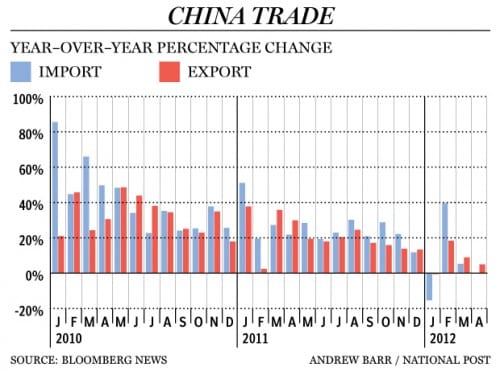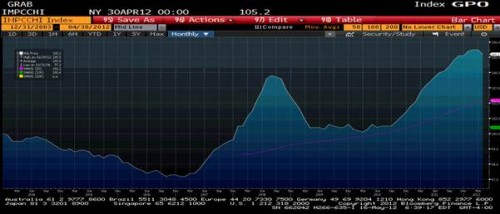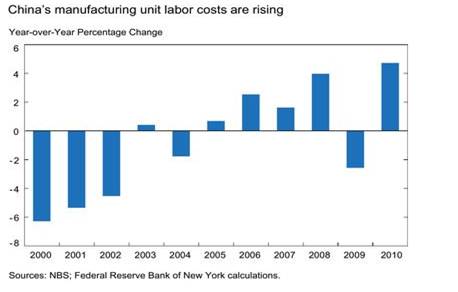In recent months, we have seen a precipitous drop in Chinese trade growth. This comes from both the export and the import side.
What’s happening?
A large part of it is wages. As I indicated two years ago, China has already sucked a large portion of the labour out of its countryside villages. And that has buoyed wage growth. Research by Chinese economists on the Lewis Turning Point indicated that the resultant coastal city labour shortage could spell inflation and trade deficits for China. But the increase in wages could have a beneficial effect if it led to higher domestic demand growth as China moved more production inward and moved to more capital and less labour intensive manufacturing. I wrote then that:
The corollaries of this increase in wages and lower productivity are slower GDP growth, higher consumption, lower savings and a deteriorating external balance of payments aka current account deficits.
What we have seen in the two years since fits this picture, but only somewhat, because while the external account is deteriorating, import growth is shrinking along with export growth. So, it is not that the Chinese are buying more stuff from abroad and foreigners are buying less in China. It’s that demand is slowing globally, even in China.
Here’s the problem: malinvestment and financial repression. Last May, Michael Pettis postulated China was rebalancing through wage increases in order to spur domestic demand and help the Chinese economy wean itself off off export-led growth as demand in the developed economies has stagnated. That’s what you would hope China would do given the research on middle income economies and the Lewis Turning Point. So, some wealth is being transferred from corporates to households in the form of higher wages. That’s a good thing. But, Pettis’ macro view is that this rebalancing is unsustainable because it is the result of large increases in real estate and infrastructure development in the past two years.
Moreover, the wage increases is clawed back on the sly through financial repression. The reason for the large increase in capital intensity is that wealth is being transferred from households to corporates in the form of negative real interest rates, which ultimately means more precautionary savings for Chinese households who lack a social safety net in a demographically-challenged society. Michael Pettis pointed out other structural issues last year that these policies have had:
[The lower interest rate] means that labor intensive industries are bearing more than the full cost of the adjustment and capital-intensive industries are bearing a negative cost.
If this is the case, we should expect to see a shift in China from labor-intensive growth to capital-intensive growth as the former get squeezed out and the latter profit. Unfortunately that is exactly what seems to be happening. I am hearing from a lot of my friends and students (i.e. those who are sons and daughters of SME owners) that SMEs, who tend to be labor intensive, are raising wages as fast as they can and are still losing workers to SOEs, who tend to be capital intensive.
This makes a lot of sense to me. If wages are a significant share of your expenses, rising wages will squeeze you much more than if they are a small part of your expenses, especially if other expenses (namely the cost of borrowing) are declining. The fact that China’s economy is becoming even more capital intensive is almost certainly not a good thing. For one thing, it contradicts Ricardian comparative advantage.
This would suggests that China is moving the wrong way and the proof would be in productivity gains. We see some of this via a story related today by Andy Lees of AML Macro Limited:
Last week I mentioned a television programme in which a Liverpool (UK) based textile company was looking to bring production back home. The programme focussed on the poor mentality of a lot of the UK unemployed, such that 1/3rd of the people hired didn’t bother sticking with the job. This week however it ran through the relative competitiveness. In 2004 the factory had shifted most of its production to China. At the time, the cost of production in the UK was higher than the end retail price the Chinese were able to offer. Unless the production was shifted over to China the company would have gone bankrupt. The UK side was scaled down aggressively to smaller premises focussing on higher cost textiles which carried premium prices whilst the bulk of the operations was shifted over to China, and expanded several times subsequently.
Now China cannot compete. Whilst the Chinese work far longer hours and work 6 days a week, their productivity is very low. The UK manufacturer, when adjusted for shipping costs can outcompete them now even on the lowest cost products. The CEO said that the pace of relative change is amazing. Even 3 or 4 years ago he would never have thought that Britain had a chance, but now he feels China is “close to a tipping point” whereby it is simply priced out across the board. Last year the cost of producing a cheap cushion was 55p cheaper in China – (these things cost no more than GBP2.00) – whereas now it had fallen to 8p, which when adjusting for management time, the inventory that needs to be carried in terms of transport time etc meant it was just not an option anymore. Whilst it had become obvious that China was losing its competitive edge, the CEO had initially thought the tipping point would have been 2 or 3 years down the line, but it is not; he says it is today.
The last update of Chinese wage growth as a whole was for 2010 when it rose 13.5%. The average of the 5 years to the end of 2010 was 15.2%. We saw earlier in the year Foxconn raising wages by between 16% and 25%. Anecdotally on the programme it showed a huge turnover of staff as people were leaving for 50% pay increases. Had he not shifted production to China in 2004, his company would have gone bankrupt. Now with wage costs rising at least 10% pa, and China now at the tipping point, presumably it wouldn’t take long for a similar thing to happen in reverse. In the next year or two, production could be 20% more expensive in China than the UK.
Clearly some of this story have to do with exchange rates and shipping costs. See this Bloomberg chart from Andy.
But the larger story is about China losing competitiveness as I was writing at this time last year. Another chart from Andy Lees, this time on Chinese unit labour costs below tells the picture.
The result has been no real increase in consumption as a percent of GDP even while the trade surplus begins to dwindle due to declining global growth.
Bottom line: China has to import commodities to fuel growth. But the combination of high labour and commodity costs and the popping of China’s property bubble has caused many capital intensive investments to turn NPV negative. And the situation has reached the Ponzi stage where even the cash flow on these projects is negative. So while China still has to rebalance toward consumption, its loss of competitiveness is a big problem for it being able to do so. These events are macro bearish on China and increase the likelihood of a hard landing.



Comments are closed.